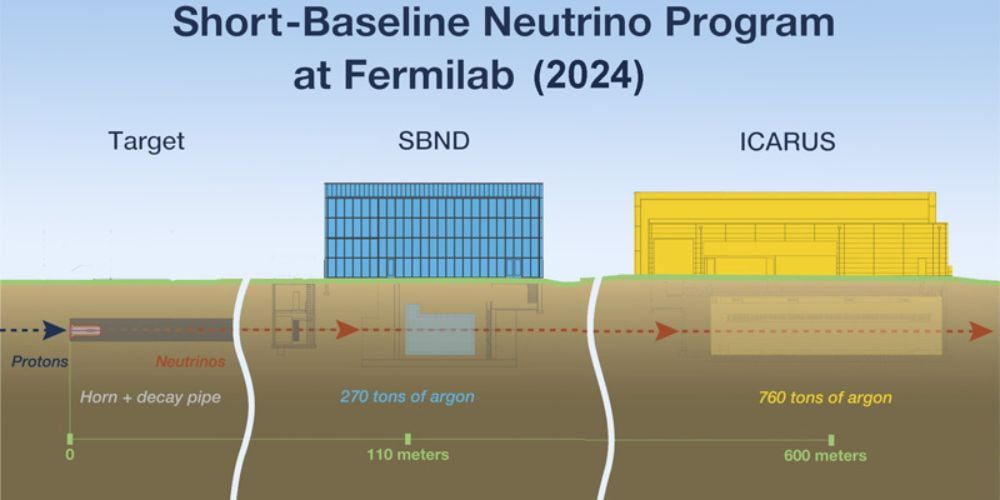UT Arlington scientists part of neutrino discovery
Thursday, Sep 26, 2024 • Katherine Egan Bennett : contact

Scientists from The University of Texas at Arlington are part of the Short-Baseline Near Detector (SBND) project at Fermi National Accelerator Laboratory in Illinois that has identified the detector’s neutrino interactions for the first time. The discovery was made after nearly a decade of planning, prototyping, and constructing the detector by an international collaboration of scientists.
The Neutrino Group at UTA, under the leadership of physics Professors Andrew Brandt and Jaehoon Yu, Associate Professor Jonathan Asaadi, and Assistant Professor Raquel Castillo Fernández, is playing a critical role in advancing research within the SBND experiment. Also contributing to UTA’s efforts on the project are postdoctoral researcher Leo Aliaga Soplín, graduate students Shweta Yadav and Manuel Dall’Olio, and former UTA postdoctoral student Gabriela Vitti Stenico.
“This is an exciting milestone. We have worked for years to get to this point and now we can focus on moving the project forward as we search for new physics,” Dr. Castillo Fernández said. “The existence of sterile neutrinos has captivated the scientific community for decades, and with this incredible detector, we are on the verge of breakthroughs that could redefine our understanding of the universe. The excitement and potential ahead are truly inspiring.”
SBND is the final element that completes Fermilab’s Short-Baseline Neutrino (SBN) Program and will play a critical role in solving a decades-old mystery in particle physics. Getting SBND to this point has been an international effort. The detector was built by an international collaboration of 250 physicists and engineers from Brazil, Spain, Switzerland, the United Kingdom, and the United States.
Neutrinos are the second most abundant particle in the universe. Despite being so abundant, they’re incredibly difficult to study because they only interact through gravity and the weak nuclear force, meaning they hardly ever show up in a detector.
Neutrinos come in three types—muon, electron, and tau. Perhaps the strangest thing about these particles is that they can change from type to type, switching from muon to electron to tau. Scientists have a good idea of how many of each type of neutrino should be present at different distances from a neutrino source. Yet observations from a few previous neutrino experiments disagreed with those predictions, leading some researchers to believe there may be more than three types.
The SBN Program at Fermilab will perform searches for neutrino oscillation and look for evidence that could point to a fourth neutrino. SBND is the near detector for the SBN Program, while ICARUS, which started collecting data in 2021, is the far detector. A third detector called MicroBooNE finished recording particle collisions with the same neutrino beamline that same year.
SBND expects to see as many as 7,000 interactions per day, more neutrinos than any other detector of its kind. The large data sample will allow researchers to study neutrino interactions with unprecedented precision.
The SBND international collaboration is hosted by the U.S. Department of Energy’s Fermi National Accelerator Laboratory. The collaboration consists of 38 partner institutions, including national labs and universities from five countries. SBND is one of two particle detectors in the SBN Program that provides information on a beam of neutrinos created by Fermilab's particle accelerators.
About The University of Texas at Arlington (UTA)
Located in the heart of the Dallas-Fort Worth Metroplex, The University of Texas at Arlington is a comprehensive teaching, research, and public service institution dedicated to the advancement of knowledge through scholarship and creative work. With an enrollment of approximately 41,000 students, UT Arlington is the second-largest institution in the UT System. UTA’s combination of outstanding academics and innovative research contributes to its designation as a Carnegie R-1 “Very High Research Activity” institution, a significant milestone of excellence. The University is designated as a Hispanic Serving-Institution and an Asian American Native American Pacific Islander-Serving Institution by the U.S. Department of Education and has earned the Seal of Excelencia for its commitment to accelerating Latino student success. The University ranks as the No. 1 national public university in the U.S. for veterans (Military Times, 2024), No. 4 in Texas for advancing social mobility (U.S. News & World Report, 2025), and No. 6 in the United States for its undergraduate ethnic diversity (U.S. News & World Report, 2025). UT Arlington’s approximately 270,000 alumni occupy leadership positions at many of the 21 Fortune 500 companies headquartered in North Texas and contribute to the University’s $28.8 billion annual economic impact on Texas.

Latest News
- Ice-T shares hard-earned wisdom with UTA studentsDuring a master class with students, the rap legend and TV star spoke candidly about humility, hustle and how he turned early struggles into success
- UTA's 23 patents strengthen UT System's No 3 rankingResearch contributions help boost the UT System’s position among the nation’s top innovators in patent technology
- UTA professor explores healing power of musicInspired by Alzheimer’s-stricken Glen Campbell, UT Arlington’s Rhonda Winegar explores how music therapy can support neurological care
- Drone duel puts UTA's UA tech to the testStudents from universities in three states faced off at Maverick Stadium in a competition focused on precision and innovation
- Ice-T brings his story to UTA’s Maverick Speakers SeriesThe iconic rapper, actor and author will discuss his rise from the streets to stardom
- Four UTA faculty named NAI Senior MembersNational Academy of Inventors recognizes their groundbreaking work in chemistry, engineering and health care






